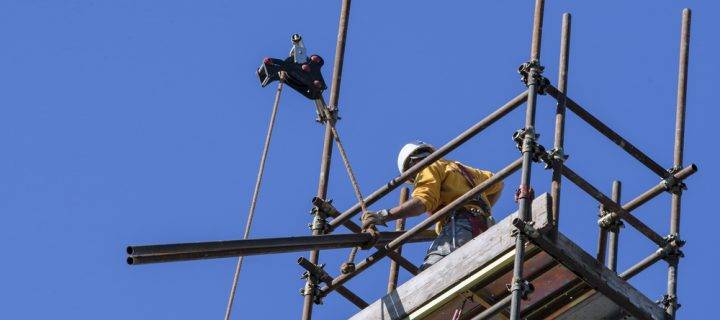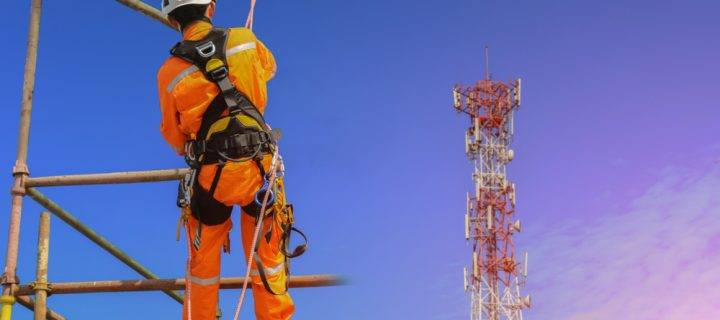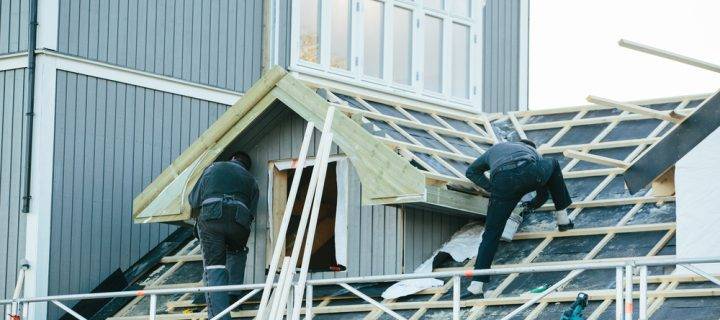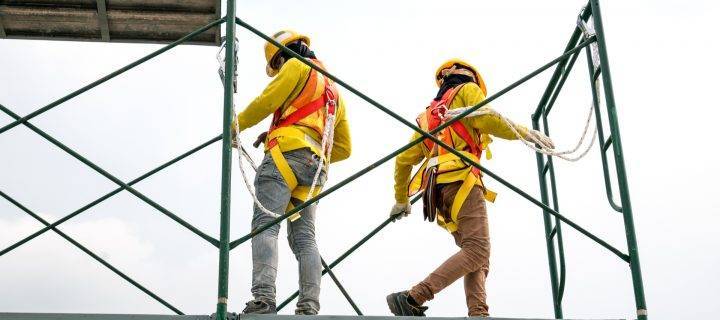Alloy towers hold many advantages over ladders for jobs that need completing around homes or in the garden. Network Scaffold is the leading supplier of scaffolding and scaffold towers across Derbyshire, which is why we have put together five reasons you should be choosing them every time. Five Reasons to Use Scaffold Towers 1. Safety – Scaffolding towers are much safer than ladders, as they have a wider surface area plus they are supported on four legs making them free-standing. Ladders, on the other hand, are on two legs and rest at an angle. Ensuring you have a flat platform to work on is much more stable and do not have to worry about falling off a ladder that could wobble and requires closer supervision and care when in use. Safety is the top priority for scaffold towers and is made clear from erecting the scaffold to dismantling it. 2. The Platform – The platform on alloy towers allows you to move around more freely and have your tools and equipment close by, plus you can leave it in place for longer. Eliminating the hassle of moving ladders, using a tower will prove a great time saver. The structures platform reduces the need for accompanying assistance, whereas with a ladder you will need someone at the base to make sure it is secure. Platforms are also equipped with bars or guide rails to prevent users from falling off, which enhances its safety. 3. Easy to Work On – Alloy towers make jobs such as painting and de-guttering quite straightforward, helping you gain access to difficult to reach areas. The ability to work more easily means that work will be completed faster. Ladders are useful for smaller tasks, but if you need a more robust and professional piece of equipment then scaffold towers are the best choice. 4. Straightforward to Manoeuvre – Scaffold towers are usually equipped with wheels, which allows users to change the location of the tower easily, compared to cumbersome ladders. Whilst moving a tower you should always reduce the height to no higher than 4 metres. Before moving the tower ensure the ground is stable and there are no risks to the tower or the user...
Read Moreabout Choosing Scaffold Towers Instead of a LadderThe Coronavirus has had a significant impact on businesses, affecting operations, supply chains, customer engagement and service. Here at Network Scaffold, we understand the challenges this has created in the scaffolding sector, with regards to protecting workers and the general public. Recently the Scaffolding Association has released guidelines to help scaffolding firms handle this tricky situation, whilst continuing to provide a vital service to clients. For our latest blog, we are going to focus on the guidance for on-site workers plus the necessary PPE equipment that will be made available. Coronavirus – Working Onsite for Scaffolders The health and safety requirements must not be compromised and if the scaffolding task cannot be undertaken safely then it should not take place. According to the Scaffolding Association, the following measures should be considered when employees are undertaking necessary work onsite – Planning work to minimise contact with other site users, which could include altering shift patterns or restricting access to work areas. Complying with social distancing measures and keeping 2 metres apart. While working on scaffolding this would equate to being approximately one bay apart vertically or every other life horizontally. Using stairs in preference to lifts Use your own tools and equipment Canteens will not be operating as normal, with breaks staggered with employees bringing their own prepared meals and drinks whilst adhering to social distancing measures. Soap and water should be easily accessible and where not possible, hand sanitiser. Sufficient waste bins for handtowels, which should be regularly removed and disposed of. Keeping a sufficient supply of additional soap, hand sanitiser and paper towels Personal Protective Equipment Onsite Guidelines When Personal Protective Equipment is provided for employees, the following measures need to be implemented – Gloves should be considered a minimum precaution Where RPE (Respiratory Protective Equipment) is prescribed the user should have this face fit tested Re-usable PPE requires a thorough clean after use and must not be shared with other workers Single-use PPE should be disposed of to ensure it is not reused Got any Questions? Get in Touch If you have any questions about our scaffolding services, please contact Network Scaffold...
Read Moreabout Coronavirus Guidelines for Scaffolding Firms ExplainedAs the Coronavirus continues to spread all over the world, we need to look at how it could potentially impact the scaffolding sector. There have been thousands of cases reported worldwide, with 596 cases confirmed in the UK at the time of writing this post. Although drastic measures such as closing schools, cancelling events, banning large public gatherings and working from home have been mentioned – this simply isn’t possible within the scaffolding and wider construction industry. Reports have suggested that up to 80% of workers could be unable to work during the forthcoming weeks of the outbreak. Evidence has shown the COVID-19 virus is already present in the industry after EDF reported that one of its workers on Hinckley Point C where two nuclear reactors are being built, has contracted Coronavirus. The latest advice from the UK Government is that workers with symptoms of COVOD-19 are advised to self-isolate for two weeks. The Impact on the Supply Chain Supply chains could be impacted with some scaffolding materials like tube and fittings imported by some providers, from the virus’ country of origin – China. For Network Scaffold, and its employees it is very much business as usual unless we communicate otherwise. Advice on Avoiding Coronavirus The NHS has suggested the following measures to avoid catching and spreading coronavirus – • Wash your hands with soap and water often – do this for at least 20 seconds. • Always wash your hands when you get home or into work. • Use hand sanitiser gel if soap and water are not available • Cover your mouth and nose with a tissue or your sleeve (not your hands) when you cough or sneeze. • Put used tissues in the bin straight away and wash your hands afterwards. • Try to avoid close contact with people who are unwell. • Do not touch your eyes, nose or mouth if your hands are not clean. Contact Us for More Information If you have any questions about our scaffolding services, please get in touch today. Network Scaffold offer scaffolding, access scaffolding, edge protection and alloy towers for projects right across Derbyshire and the surrounding...
Read Moreabout The Impact of Coronavirus on the Scaffolding IndustryReplacing tiles, repairing cracks and structural jobs are all complex tasks for carrying out roof repairs. Network Scaffold would always recommend you work with a qualified roofing professional, as they all have several risks for both access and safety that you need to be aware of. The important question is – do you need scaffold or a ladder for roof repairs? Scaffolding will cost you more, but can put a price on safety? What you get with scaffolding from Network Scaffold, is high-quality scaffold from accredited professionals who are members of the Scaffolding Association. Below we are going to provide the necessary guidelines for your next project to help to make an informed decision. What Size is the Project and How Can Scaffolding Help? For smaller projects, such as a minor gutter repair or fallen roof tile towards the edge of the roof that only needs one of two people – you will be okay using a ladder. However, for larger repairs such as laying new roof tiles across your whole roof requires a proper risk assessment report – meaning you need scaffolding. Jobs that require work on your entire roof are also going to need scaffold, as it gives those carrying out repairs a safe and sturdy platform to stand on and carry out the work more efficiently than going up and down a ladder every few seconds. For workers on the ground, scaffolding is also safer, as if the scaffold is fitted with edge protection it will alleviate the risk of materials falling and causing injuries. Chutes can also be installed to allow the safe transportation of materials. How Long Could Your Project Take? If your project takes longer than a day, using scaffold is always the best option, as it is more efficient plus the fact the elements can take their toll over a number of days. Scaffolding is much more robust in harsher conditions compared to a ladder. With the recent Storm David, Storm Ciara and Storm Jorge reinforcing this point. Want to Know More about Scaffolding? Contact Us Today If you want to know more about scaffolding for commercial and domestic projects, please get in touch with Network Scaffold...
Read Moreabout Roofing Repairs using ScaffoldingHere at Network Scaffold, we understand the importance of providing the safest scaffolding for both commercial and domestic projects. For our latest blog, we are going to explain the legal requirements, competence and supervision guidelines for scaffolding. All scaffolds must be erected, altered and dismantled in a safe manner, which is achieved by referring to guidelines provided by the National Access & Scaffolding Confederation (NASC) in a document called SG4: Preventing Falls in Scaffolding. Contractors need to follow similar guidance provided by the manufacturers of their scaffolding system (such as Network Scaffold) or by consulting Access Design & Safety literature on Design Safe. Contractors need to be aware that any proposed alterations or modifications which takes scaffold outside of a generally recognised TG20 configuration must be designed, checked and proven via calculations by a competent person. What Should Scaffold Design Include? Work at Height Regulations 2005 state that unless scaffolding is assembled to a recognised configuration and must be designed by a competent person with bespoke calculation. This ensures the scaffold will have required rigidity, strength and stability during the erection, use and dismantling. Competence and Supervision Guidelines for Scaffold Employees must be competent for scaffolding work they undertake and receive sufficient training which is relevant to the complexity of the scaffolding they are working with. At the minimum, each member of your scaffolding team needs to contain a competent person who has the appropriate level of training needed for the scaffold they are working with, that covers how to erect, alter and dismantle the scaffold. Trainee and apprentice scaffolders should always be directly supervised by a competent person. Any operative who has yet to complete approved training methods and assessment should be considered trainees. Want to Know More? Get in Touch If you have any more questions about our services, please contact us today. Network Scaffold is the leading suppliers of scaffold and access scaffold across the East Midlands – including Derby and...
Read Moreabout Understanding the Legal Requirements of Scaffolding




